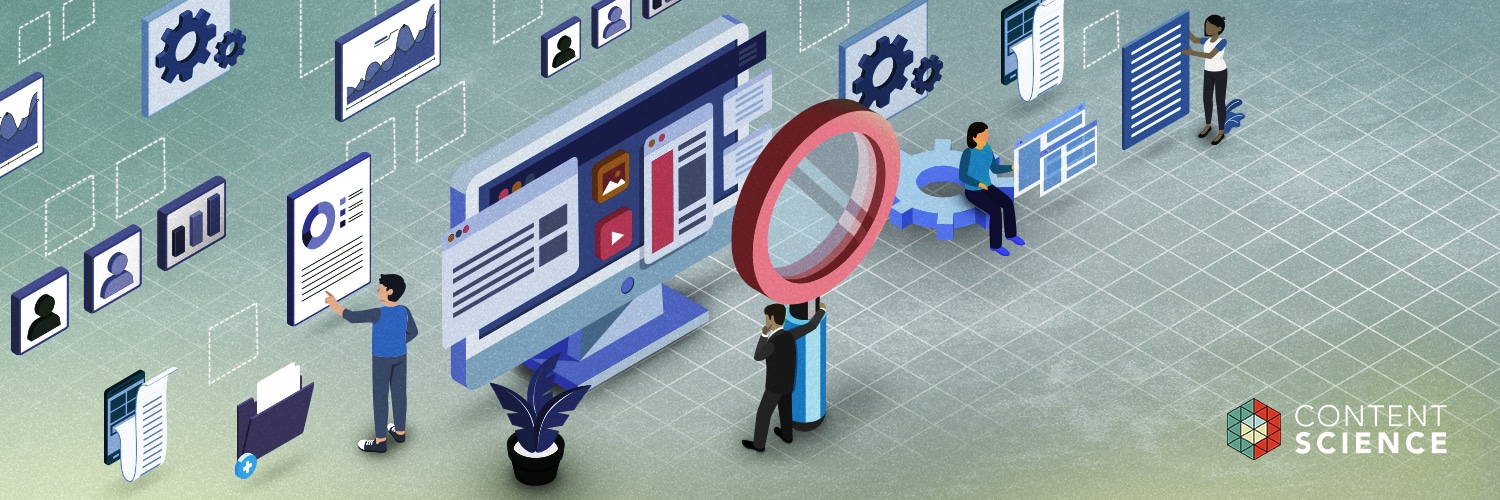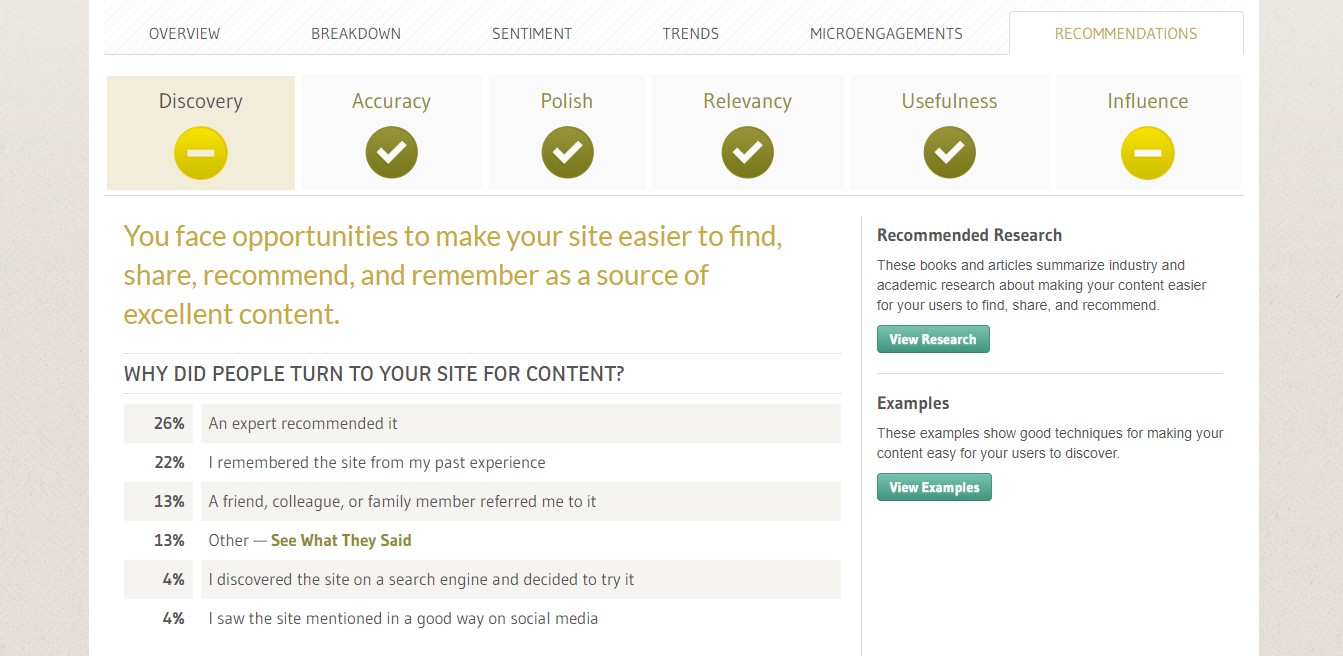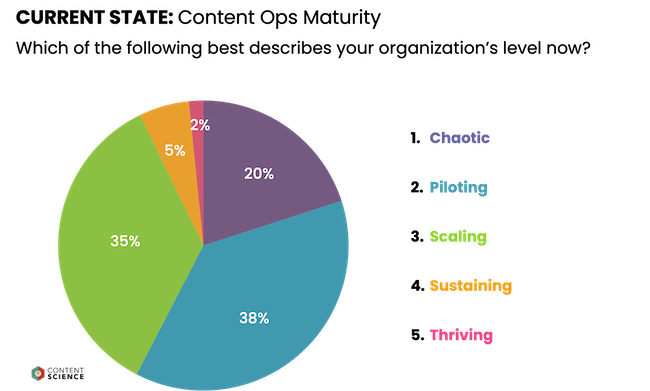
Conducting a content analysis is an essential step to inform your content strategy. But where do you start? This article walks through the key steps.
When analyzing your current content situation, focus on the three C’s:
- Content,
- Customers (or users), and
- Context.
If you have not analyzed your content, customers, or context recently, then expect the effort to take one to three weeks, at least. For large and enterprise companies, expect at least four weeks, says Content Science founder Colleen Jones in her book The Content Advantage: The Science of Succeeding at Digital Business through Effective Content.
Now let’s walk through each of these areas.
1. Perform a Content Audit
A content audit is a close look at your existing content.
Get started with an inventory: The content audit starts with a content inventory. The inventory assembles a list and description of the content assets—pages, images, documents, videos, components, and more—that compose your website or digital experiences. You might be able to export the inventory, or at least part of it, from your content management system (CMS). More often, especially when you’re dealing with large sites or digital experiences, you will need to assemble the inventory from a combination of sources, including a spidering tool, a report from your CMS, a report from your analytics platform, and manual review. You can assemble the inventory in a spreadsheet and track key characteristics of the content.
Audit the content two ways: Once you have an inventory together, you can audit the content quantitatively and qualitatively.
Conduct a quantitative audit: The most useful quantitative audit is a performance audit. To understand performance of the content, assemble analytics into your content inventory. Common sources of this quantitative data are your analytics tool, your content management system, and your social media management tool.
Review content quality: Doing a qualitative audit of your content can help shed light on why content performs as it does, how customers perceive it, and whether it meets your company’s standards for user experience, brand, accessibility, compliance, and more. The process is straightforward:
- Select a content sample.
- Choose your review criteria. (You can use our Content Quality Checklist)
- Review the sample or have a content expert review it.
- If needed, identify areas for additional review.
- Summarize and share insights.
2. Assess Customer Needs and Perceptions
Understanding your customers’ perspectives will help you further understand why content is performing as it does and gain ideas for improving the content to consider in your strategy.
Update customer journey maps and personas: If your company does not already have customer journeys or personas based on solid research, you need them. Ideally, you will have a customer journey map for each main persona, or customer type.
Map existing content to customer journeys: When you have a solid understanding of your customers’ journeys and the existing content (or source material), you can map your existing content to those journeys. This process will help you see:
- Where your existing content meets customer needs or could meet those needs with minor changes
- Gaps between customer needs and your existing content
- Overlaps or redundancies in your content, such as having too much content to address one customer need or touchpoint
Evaluate content effectiveness: Understand how well your content works for your current customers. In our research, we identified six dimensions of content effectiveness, and these dimensions have held up over the course of collecting data from more than 150,000 people. They are:
- Discovery: How do users discover content? Do users find the content they need?
- Accuracy: Do they perceive the content as accurate?
- Polish: Do users perceive the formatting and design of the content to be a high level of quality?
- Relevance: Do they perceive the content as serving their needs or interests?
- Usefulness: Does the content anticipate the users’ needs and enable them to complete the goals?
- Influence: Do users take action or make a decision after viewing the content?
The Content Science team also developed a tool called ContentWRX to help automate this assessment, from collecting data to creating a content effectiveness score.

3. Take Context Into Account
There are numerous contextual factors that will be important to consider in your content strategy. These factors round out your content analysis.
Gauge content maturity: This area focuses on what happens “behind the scenes” with your content. Content Science has developed a set of content maturity models. Is your content team Piloting, Scaling, Sustaining, or Thriving? You can take our Content Operations Maturity Assessment to find out. Content professionals are most likely to say their company is at level 2, Piloting.

Understand brand and reputation: This area focuses on the broader perceptions that customers and potential customers have about your company and its reputation. Your marketing leadership might already have a system in place to track these perceptions. If not, then you can conduct a survey or poll as well as mine your voice of customer and social listening data.
Track technology trends and business dynamics: For the near future, you will want to consider how advances in technology, such as machine learning and artificial intelligence, can realistically help you.
Size up the competitive content landscape: The content landscape is other sources of content that your customers use or are exposed to in the course of their journeys.
Moving Forward With Content Analysis
Now that you have a good feel for how to start a content analysis, you’re ready to take the next steps. Here are some suggestions for how to go from idea to implementation with help from Content Science:
Dig in deeper with a certification course: This article features content from Content Science’s Content Strategy + Analysis Certification program, which is part of our Content Science Academy. The certification course goes in depth into content auditing,user journeys (that work for content), content analytics, and competitive content analysis—and provides examples, practice assignments, and tools to get you going.
Get guidance from The Content Advantage: There are even more content analysis insights and examples in The Content Advantage. You can use the information in the book to help you interpret and act on your content analysis as you go.
Partner with Content Science: We are here to help you. If your organization is ready to get to work on a content analysis, you can engage Content Science to conduct an in-depth large-scale analysis efficiently and effectively.
Events, Resources, + More
The Ultimate Guide to End-to-End Content
Discover why + how an end-to-end approach is critical in the age of AI with this comprehensive white paper.
The Content Advantage Book
The much-anticipated third edition of the highly rated book by Colleen Jones is available at book retailers worldwide. Learn more!
20 Signs of a Content Problem in a High-Stakes Initiative
Use this white paper to diagnose the problem so you can achieve the right solution faster.
Upskill with Content Science Academy
Training for modern content roles through on-demand certifications + courses or live workshops.






Comments
We invite you to share your perspective in a constructive way. To comment, please sign in or register. Our moderating team will review all comments and may edit them for clarity. Our team also may delete comments that are off-topic or disrespectful. All postings become the property of
Content Science Review.